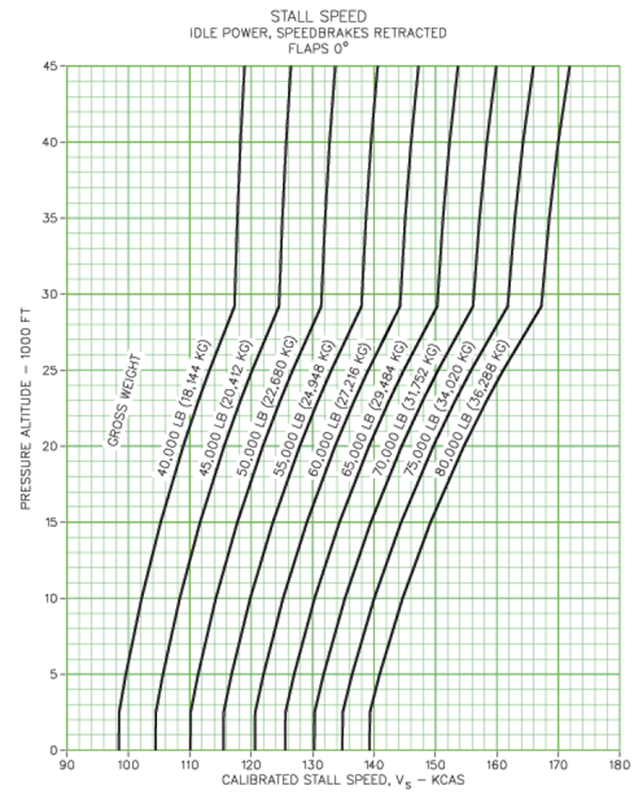The reference stall speed is what ends up producing many of the numbers that matter to you, such as V2 and VREF. You should never see it in flight if you have a stick pusher, provided you allow the stick pusher to do its job.
— James Albright

Updated:
2012-09-12
The key takeaway from this discussion, however, has nothing to do with normal flight operations. You should note that VSR is measured during test conditions on a fully trimmed aircraft, 1-G flight, using a measured deceleration. If you are turning, decelerating more than 1 knot per second, or have any other conditions outside what the pilots used to produce these numbers, you aircraft is going to stall at a higher speed.
Before getting into the aero engineering, how about a Stall IQ test?
- As the angle of attack is increased, so to does the coefficient of lift until a point where it decreases as rapidly as it increased. TRUE or FALSE?
- The wing tends to stall from the root to the tip, giving you adequate control of the ailerons during the initial phase of the stall. TRUE or FALSE?
- The aircraft will tend to pitch down once the wing has been fully stalled. TRUE or FALSE?
- A proper stall recovery can be made by increasing thrust or decreasing pitch while minimizing altitude loss. TRUE or FALSE?
If you answered TRUE to each question, congratulations, you are qualified to be a Cessna 152 pilot. If you answered FALSE to each question, you are qualified to fly a swept wing, T-tailed jet. See Stall Recovery for more about this.

1
Regulatory
VSR means reference stalling speed.
Source: 14 CFR 1.2
(a) The reference stall speed, VSR, is a calibrated airspeed defined by the applicant. VSR may not be less than a 1-g stall speed. VSR is expressed as:
where:
VCL MAX = Calibrated airspeed obtained when the load factor-corrected lift coefficient
is first a maximum during the maneuver prescribed in paragraph (c) of this section. In addition, when the maneuver is limited by a device that abruptly pushes the nose down at a selected angle of attack (e.g., a stick pusher), VCL MAX may not be less than the speed existing at the instant the device operates;
nZW = Load factor normal to the flight path at VCL MAX
W = Airplane gross weight;
S = Aerodynamic reference wing area; and
q = Dynamic pressure.
(b) VCL MAX is determined with:
(1) Engines idling, or, if that resultant thrust causes an appreciable decrease in stall speed, not more than zero thrust at the stall speed;
(2) Propeller pitch controls (if applicable) in the takeoff position;
(3) The airplane in other respects (such as flaps, landing gear, and ice accretions) in the condition existing in the test or performance standard in which VSR is being used;
(4) The weight used when VSR is being used as a factor to determine compliance with a required performance standard;
(5) The center of gravity position that results in the highest value of reference stall speed; and
(6) The airplane trimmed for straight flight at a speed selected by the applicant, but not less than 1.13VSR and not greater than 1.3VSR.
(c) Starting from the stabilized trim condition, apply the longitudinal control to decelerate the airplane so that the speed reduction does not exceed one knot per second.
(d) In addition to the requirements of paragraph (a) of this section, when a device that abruptly pushes the nose down at a selected angle of attack (e.g., a stick pusher) is installed, the reference stall speed, VSR , may not be less than 2 knots or 2 percent, whichever is greater, above the speed at which the device operates.
Source: 14 CFR 25.103] Stall speed.
2
What it really means
VSR is a speed:
- Established by the aircraft manufacturer.
- Which cannot be less than the speed a stick pusher (if installed) activates.
- Found in test conditions with the aircraft in trim, stabilized no lower than 13% above VSR and no higher than 30% above VSR, engines at idle (in most cases), and pitch adjusted to decrease airspeed no higher than 1 knot per second.
While VS is defined by 14 CFR 1.2 as "the stalling speed or the minimum steady flight speed at which the airplane is controllable," VSR is further defined as "not less than a 1-g stall speed.
3
Gulfstream example

G450 Stall Speed, Idle Power, Speed Brakes Retracted, Flaps 0°, from [G450 AFM, pg. 5.1-33]
The G450, for example, provides several charts for VS at varying configurations at idle power as a function of gross weight and pressure altitude. While not specifically noted, these are presumed to be a 1-G flight which makes them the same as VSR.
References
(Source material)
14 CFR 1, Title 14: Aeronautics and Space, Definitions and Abbreviations, Federal Aviation Administration, Department of Transportation
14 CFR 25, Title 14: Aeronautics and Space, Federal Aviation Administration, Department of Transportation
Gulfstream G450 Airplane Flight Manual, Revision 35, April 18, 2013.
Please note: Gulfstream Aerospace Corporation has no affiliation or connection whatsoever with this website, and Gulfstream does not review, endorse, or approve any of the content included on the site. As a result, Gulfstream is not responsible or liable for your use of any materials or information obtained from this site.